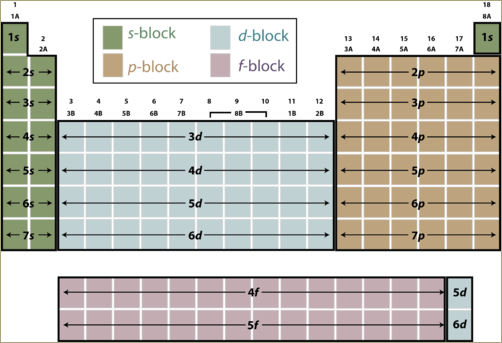
Concept explainers
Interpretation:
The relation between the arrangements of electrons in an atom with the location of the atom on the periodic table is to be described.
Concept introduction:
A periodic table can be divided into four zones, s block, p block, d block and f block. The element belonging to a particular block will have its outermost electron in that particular subshell. For example, in the case of s block elements, the outermost electrons will occupy the subshell. Elements in p block will have its outermost electrons in p subshell.
Explanation of Solution
Electrons revolve around the nucleus in orbits. These orbits are called shells. The shells are numbered as n = 1, 2, 3, 4, and so on. In an

Any element located in the s block will have its outermost electron(s) in s subshell. On moving across the periodic table from one element to the next, one additional proton and one additional electron are added, along with one or more neutrons. Each additional electron goes into a specific subshell. If an atom is located in the p block of the table, the last electron is placed into a p subshell. If an atom is located in the d block of the table, the last electron is placed into a d subshell and so on.
The element belonging to a particular block will have its outermost electron in that particular subshell.
The elements in each block have related properties. The elements in the s-block are reactive metals. The elements in the d-block tend to form colorful compounds that are used as pigments. The elements in the p-block form colorless compounds.
By knowing the position of an element on a periodic table, one can predict the arrangement of electrons. The periodic table provides the information needed to write electronic configurations.
Chapter U1 Solutions
Living By Chemistry: First Edition Textbook
Additional Science Textbook Solutions
Chemistry: An Introduction to General, Organic, and Biological Chemistry (12th Edition) - Standalone book
Organic Chemistry
Chemistry (7th Edition)
Chemistry
Chemistry: A Molecular Approach (4th Edition)
Chemistry & Chemical Reactivity
 ChemistryChemistryISBN:9781305957404Author:Steven S. Zumdahl, Susan A. Zumdahl, Donald J. DeCostePublisher:Cengage Learning
ChemistryChemistryISBN:9781305957404Author:Steven S. Zumdahl, Susan A. Zumdahl, Donald J. DeCostePublisher:Cengage Learning ChemistryChemistryISBN:9781259911156Author:Raymond Chang Dr., Jason Overby ProfessorPublisher:McGraw-Hill Education
ChemistryChemistryISBN:9781259911156Author:Raymond Chang Dr., Jason Overby ProfessorPublisher:McGraw-Hill Education Principles of Instrumental AnalysisChemistryISBN:9781305577213Author:Douglas A. Skoog, F. James Holler, Stanley R. CrouchPublisher:Cengage Learning
Principles of Instrumental AnalysisChemistryISBN:9781305577213Author:Douglas A. Skoog, F. James Holler, Stanley R. CrouchPublisher:Cengage Learning Organic ChemistryChemistryISBN:9780078021558Author:Janice Gorzynski Smith Dr.Publisher:McGraw-Hill Education
Organic ChemistryChemistryISBN:9780078021558Author:Janice Gorzynski Smith Dr.Publisher:McGraw-Hill Education Chemistry: Principles and ReactionsChemistryISBN:9781305079373Author:William L. Masterton, Cecile N. HurleyPublisher:Cengage Learning
Chemistry: Principles and ReactionsChemistryISBN:9781305079373Author:William L. Masterton, Cecile N. HurleyPublisher:Cengage Learning Elementary Principles of Chemical Processes, Bind...ChemistryISBN:9781118431221Author:Richard M. Felder, Ronald W. Rousseau, Lisa G. BullardPublisher:WILEY
Elementary Principles of Chemical Processes, Bind...ChemistryISBN:9781118431221Author:Richard M. Felder, Ronald W. Rousseau, Lisa G. BullardPublisher:WILEY





